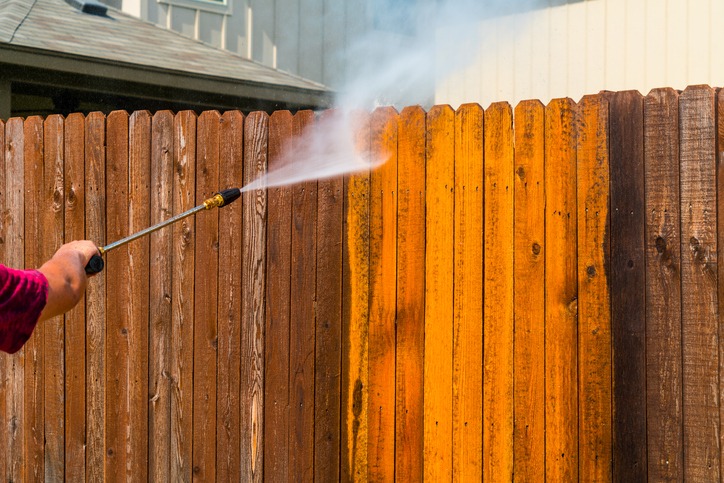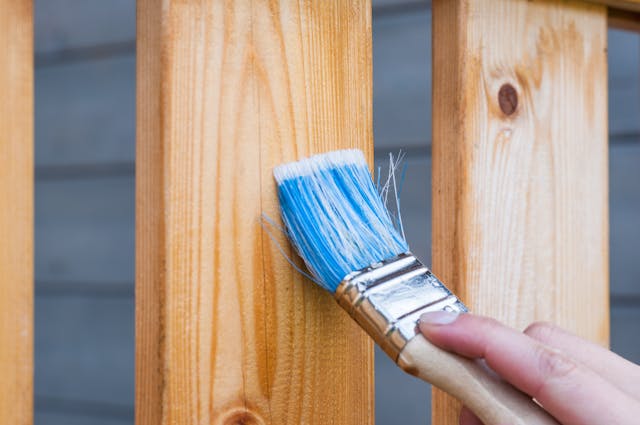To keep your wooden fence in top shape, start by checking for loose boards or any signs of rot. Don’t ignore small issues like loose nails—they’re early signs of bigger troubles. Regularly clean your fence to prevent buildup of dirt and moss; a quick brush-off followed by a pressure wash does wonders. Stubborn stains? Use a wood cleaner. Always finish with a protective sealant to guard against moisture and UV damage, enhancing your fence’s longevity. Tighten any loose screws and replace damaged boards promptly to maintain its structure. Seasonal care, including a pre-winter sealant application, is key. Stick with us for even more insights on keeping your wooden fence looking good as new.
Key Takeaways
- Regularly inspect for loose boards, rust, and signs of rot to prevent further damage.
- Clean the fence with a pressure washer and wood cleaner to remove dirt and stains.
- Apply a protective sealant or paint to shield from moisture, UV damage, and prevent rot.
- Promptly repair or replace damaged sections to maintain structural integrity and appearance.
- Adjust maintenance and protection efforts seasonally, especially before winter, to prevent warping or rot.
Assessing Fence Condition
To keep your wooden fence in top shape, start by checking for loose boards, rusted hardware, and signs of rot. It’s important to inspect your fence thoroughly to identify any structural issues or damaged sections that could compromise its integrity. This step is the foundation of wooden fence maintenance tips because catching problems early can prevent them from worsening.
When you’re evaluating the condition of your fence, don’t just give it a quick glance. Take your time to examine every part for any signs of damage. Look for loose nails or screws, as these can be early indicators of more significant problems. If you spot any, it’s vital to address them promptly to maintain the fence’s functionality and prolong its lifespan.
Regular maintenance is not just about fixing what’s broken; it’s about preventing future issues. By conducting a comprehensive assessment of your fence at regular intervals, you can plan maintenance and repairs accordingly. This proactive approach ensures that your fence remains strong and durable, keeping your property safe and enhancing its aesthetic appeal. Remember, a well-maintained fence is an investment in the longevity of your property.
Cleaning and Maintenance
After evaluating your fence’s condition, it’s vital to regularly clean it to prevent dirt, grime, and moss from harming the wood. Wooden fences, exposed to the elements, can quickly accumulate unwanted layers that, if left unchecked, degrade the wood’s integrity and appearance. Start by brushing away surface dirt to tackle this issue head-on. A pressure washer can then be your best ally, offering a thorough cleanse that readies the fence for further maintenance.
However, it’s not just about blasting away the dirt; using a wood cleaner can enhance your efforts. This step is essential for tackling stubborn stains and making sure the wood species of your fence gets the care it needs. Daily maintenance, albeit less intensive, plays a pivotal role in warding off mold and mildew, both notorious for shortening a wooden fence’s lifespan.
Lastly, don’t overlook the importance of applying a protective sealant after cleaning. This barrier shields the wood from moisture and UV damage, extending the time between major cleanings and minor repairs. By incorporating these practices into your routine, you’ll guarantee your wooden fence remains a durable, visually appealing boundary for years to come.
Repairing Damage
Inspecting your wooden fence for damage is the first step in ensuring its longevity and safety. Don’t overlook any broken or rotten boards; replace them promptly. This isn’t just about maintaining the fence’s look; it’s critical for preserving its structural integrity. Loose screws or nails? Tighten them. Delaying these simple fixes can lead to further damage, undermining the fence’s stability.
Confront structural issues head-on. Ignoring them won’t make them disappear; it’ll only escalate repair costs down the road. Timely repairs not only extend the life of your wooden fence but also keep it looking pristine. Remember, a fence in disrepair isn’t just an eyesore; it’s a safety hazard. Compromised integrity can lead to collapses, posing risks to both people and pets.
Protective Coatings
Having discussed repair, it’s now time to focus on how protective coatings can safeguard your wooden fence against the elements. Protective coatings, like sealants or paint, are your wood fence’s best defense. They’re not just about aesthetics; they’re about preservation. By applying these coatings, you’re improving your fence’s resilience against moisture, UV rays, and the myriad of threats that can lead to rotting, warping, discoloration, and even structural damage.
Think of it this way: without a protective coat, your wooden fence is constantly exposed to water damage and the harshness of the sun. This exposure doesn’t just degrade the appearance of your fence; it compromises its integrity. A simple coat of paint or sealant acts like a shield, prolonging the life of your fence significantly.
Seasonal Adjustments
To guarantee your wooden fence stays sturdy year-round, it’s crucial to adjust your maintenance approach with the changing seasons. The weather plays a significant role in how your wooden fence looks and lasts, so keeping up with seasonal modifications is key. Here’s how you can keep your fence in good condition, no matter the time of year:
- Before winter hits, make sure to apply a protective sealant or a fresh coat of paint. This barrier can prevent moisture from seeping into the wood, which could cause it to warp or rot when it freezes and thaws.
- After winter, inspect the fence for any signs of damage or wear. The cold months can be harsh, and early detection of problems means easier fixes.
- Spring cleaning isn’t just for your home. Use this time to give your fence a good wash and check for any repairs that need to be made to ensure it doesn’t trap moisture during the rainy season.
- Regularly monitor your fence throughout the year. Keeping an eye on its condition allows you to address small issues before they turn into bigger problems.
Frequently Asked Questions
What Is the Best Way to Maintain a Wooden Fence?
To maintain a wooden fence, regularly clean it, control moisture, prevent pests, inspect for damage, and repair promptly. Choose the right paint for sun protection. These steps guarantee it stays strong and looks great.
How Do You Prolong the Life of a Wooden Fence?
To prolong your wooden fence’s life, conduct regular inspections, guarantee proper installation, and maintain ground clearance. Control moisture, shield it from sunlight, prevent pests, and stick to a cleaning regimen for the best results.
What Is the Best Way to Protect a Wood Fence?
To best protect your wood fence, choose the right stain, control moisture, shield from sunlight, prevent insect damage, minimize soil contact, guard against wind damage, and use effective cleaning methods. These steps guarantee longevity.
How Often Should You Treat a Wood Fence?
You should treat your wood fence every 1-3 years, considering climate impact and treatment types. Factor in cost, application methods, safety precautions, and environmental effects. Seasonal timing’s essential for best results. Always follow product guidelines.
Conclusion
So, you’ve got your fence’s back by evaluating, cleaning, repairing, and safeguarding it. Remember, a little effort goes a long way. Don’t overlook those seasonal checks—winter’s chill and summer’s heat won’t spare your wooden guardian. Keep it tidy, apply that protective coat, and repair what’s damaged promptly. This isn’t just upkeep; it’s showing care to that wooden barrier that keeps your area safe and private. Treat it well, and it’ll stand tall and proud for years.




